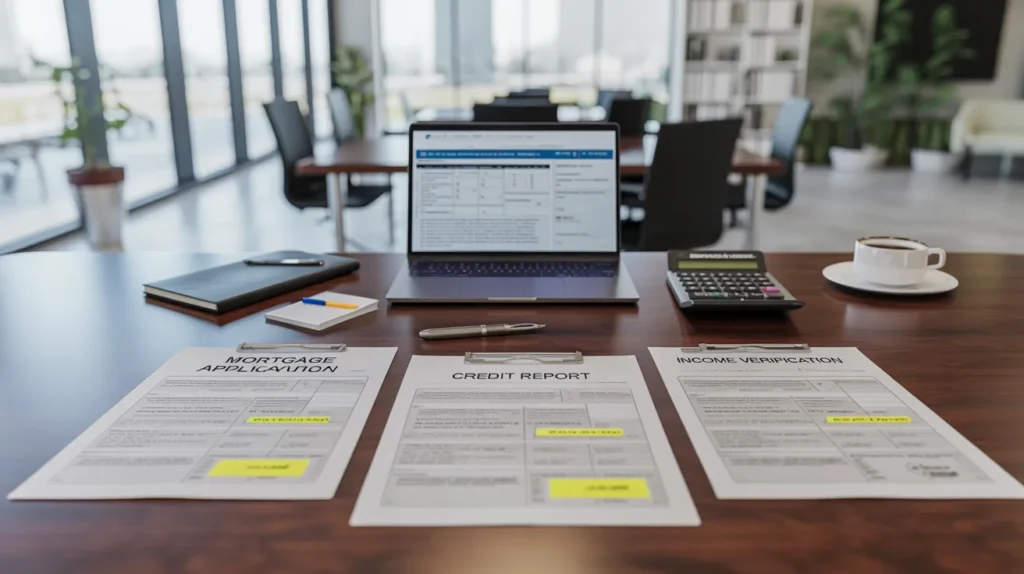How to get the best mortgage deal in 2025 means doing your homework before you apply. The UK mortgage market is competitive. Lenders want your business. But you need to know how to position yourself as the ideal borrower.
This step-by-step guide for UK homebuyers walks you through everything. You’ll learn how to prepare, compare lenders, and apply successfully. Let’s get started.
Why Getting the Best Mortgage Deal Matters
A 0.5% difference in your mortgage rate might not sound like much. But it adds up fast.
On a £250,000 mortgage over 25 years:
- At 4.5% interest: you pay £1,389 per month (£166,700 total interest)
- At 5.0% interest: you pay £1,461 per month (£188,300 total interest)
That’s £72 more per month, or £21,600 extra over the mortgage term. Getting the best mortgage deal in 2025 saves you real money.

Step 1: Check and Improve Your Credit Score
Your credit score is the first thing lenders look at. It shows how reliable you are at paying back money, and it affects whether you get approved and what interest rate you’ll pay.
How to Check Your Credit Score
Get your credit report from all three UK credit reference agencies:
- Experian
- Equifax
- TransUnion
You can check for free through services like ClearScore, Credit Karma, or directly through the agencies. Check all three because lenders use different agencies.
What Credit Score You Need
Different lenders have different requirements. But here’s a rough guide:
- Excellent (961-999 on Experian): access to the best deals
- Good (881-960): access to most competitive rates
- Fair (721-880): approved but with higher rates
- Poor (below 720): limited options, much higher rates
How to Improve Your Credit Score
If your score needs work, take these steps:
Register on the electoral roll at your current address. This is the single biggest factor for UK credit scores.
Pay all bills on time for at least six months before applying. Set up direct debits so you don’t miss payments.
Reduce your credit utilization. Keep credit card balances below 30% of your limit. Even better, keep them below 10%.
Don’t apply for new credit in the six months before your mortgage application. Each application leaves a mark on your credit file.
Check for errors on your credit report. Dispute any mistakes you find. Wrong addresses or accounts you don’t recognize can hurt your score.
Close old accounts you don’t use, but keep your oldest credit card open. Length of credit history matters.
Step 2: Calculate How Much You Can Borrow
Before you start looking at properties, know your realistic budget. Lenders use strict affordability criteria.
The Standard Calculation
Most UK lenders will lend you 4 to 4.5 times your annual income. Some lenders go up to 5 times for certain professions or circumstances.
If you earn £40,000:
- 4x income: £160,000 mortgage
- 4.5x income: £180,000 mortgage
- 5x income: £200,000 mortgage
For joint applications, lenders add both incomes together.
What Affects Your Borrowing Amount
Lenders look at more than just your income. They assess your affordability by examining:
Your monthly commitments:
- Credit card payments
- Personal loans
- Car finance
- Student loans
- Childcare costs
Your living expenses:
- Bills and utilities
- Council tax
- Food and groceries
- Transport costs
- Insurance
Your deposit size. The more you put down, the more you can borrow overall and the better rates you’ll get.
Stress Testing
Lenders stress test your mortgage. They check if you could still afford payments if interest rates rise by 2% to 3%. This is mandatory for UK mortgages.
If you’re borrowing £200,000 at 4.5%, they’ll test if you can afford payments at 6.5% to 7.5%. This protects you from payment shock if rates increase.

Step 3: Save Your Deposit and Additional Costs
The bigger your deposit, the better your mortgage deal. This step-by-step guide for UK homebuyers recommends aiming for at least 10% down.
Deposit Levels and What They Mean
5% deposit (95% LTV):
- Limited lender options
- Highest interest rates
- Stricter lending criteria
10% deposit (90% LTV):
- Good range of lenders
- Better interest rates
- More flexible terms
15% deposit (85% LTV):
- Wide choice of lenders
- Competitive interest rates
- Easier approval process
20% deposit (80% LTV):
- Access to best rates
- Most lender competition
- Strong negotiating position
Additional Costs to Budget For
Beyond your deposit, you need money for:
Valuation fee: £250 to £1,500 depending on property value and survey type
Conveyancing fees: £1,000 to £2,000 for legal work
Mortgage arrangement fee: £0 to £2,000 (sometimes you can add this to your mortgage)
Stamp duty: varies by property price and buyer status (first-time buyers get relief up to £425,000)
Moving costs: £300 to £1,500
Budget an extra £3,000 to £5,000 on top of your deposit for these costs.
Step 4: Research Different Mortgage Types
Understanding mortgage types helps you get the best mortgage deal in 2025. Each type suits different situations.
Fixed-Rate Mortgages
Your interest rate stays the same for a set period, usually two, three, five, or ten years.
Advantages:
- Payment certainty
- Protection from rate rises
- Easy to budget
Disadvantages:
- Usually higher initial rates than variable
- Early repayment charges if you leave early
- No benefit if rates fall
Best for: people who want payment stability and plan to stay put.
Variable-Rate Mortgages
Your rate can change. There are several types:
Standard Variable Rate (SVR): the lender’s default rate. Usually the most expensive option. You move to this when your fixed term ends.
Tracker mortgages: follow the Bank of England base rate, usually at a set percentage above it. If the base rate is 5% and your tracker is base rate plus 1%, you pay 6%.
Discount mortgages: a discount off the lender’s SVR for a set period. If the SVR is 7% and you get a 2% discount, you pay 5%.
Advantages:
- Often lower initial rates
- Can benefit from rate drops
- Some have no early repayment charges
Disadvantages:
- Payment uncertainty
- Could become expensive if rates rise
- Harder to budget
Best for: people comfortable with risk who think rates might fall.
Offset Mortgages
Your savings are linked to your mortgage. You don’t earn interest on your savings, but they reduce the mortgage balance you pay interest on.
Example: £200,000 mortgage with £20,000 in savings. You only pay interest on £180,000.
Best for: higher-rate taxpayers with significant savings.
Step 5: Compare Mortgage Lenders and Products
This is where you find the best mortgage deal in 2025. Don’t just look at interest rates. Consider the total cost.
Where to Compare Mortgages
Use comparison websites:
- MoneySavingExpert Mortgage Best Buys
- Which? Mortgage comparison
- MoneySuperMarket
- Confused.com
These show you rates from multiple lenders. But they don’t cover every lender. Some only work through brokers.
What to Compare Beyond Interest Rates
Total cost over the initial period. Add up all fees plus interest for the fixed or discounted period.
Example comparison for a £200,000 mortgage over five years:
Lender A:
- 4.2% rate
- £999 arrangement fee
- £0 valuation fee
- Total cost: £55,240
Lender B:
- 4.4% rate
- £0 arrangement fee
- £350 valuation fee
- Total cost: £56,890
Lender A is cheaper overall despite the higher arrangement fee.
Early repayment charges. If you might move house or remortgage early, check these carefully. Some lenders charge 5% of the outstanding balance if you leave in year one.
Overpayment allowances. Most lenders let you overpay by 10% per year without charges. Some allow more. If you plan to make overpayments, this matters.
Flexibility features:
- Payment holidays
- Ability to borrow back overpayments
- Portable mortgages (take your deal when you move)
Step 6: Use Government Schemes if Eligible
In 2025, there are several schemes still that can help first-time buyers and certain home movers:
- Lifetime ISA (LISA): Save up to £4,000 per year and get a 25% government bonus.
- First Homes Scheme: Buy new-build homes at a 30% discount if you qualify.
- Shared Ownership: Buy a share of a property (usually 25%–75%) and pay rent on the rest.
It is worth adding these to your checklist as they can help reduce your deposit size or overall cost, especially if you’re struggling to save.
Step 7: Decide Between Broker or Direct Application
You can apply for a mortgage directly with lenders or use a mortgage broker. Each approach has benefits.
Brokers also help you understand complex criteria, especially if you:
- Are self-employed
- Have variable income
- Are buying a buy-to-let property
- Have a small deposit
Using a Mortgage Broker
Brokers access deals from multiple lenders. Some have exclusive products you can’t get directly. Try and deal with a Broker who has access to ‘All the Market’ software. This means that they have a multitude of product options and lenders and are not tied to just the high street banks or building societies.
Benefits:
- They do the research for you
- Access to more lenders and products
- Help with complex situations (self-employed, bad credit, multiple income sources)
- Guide you through the application
- Some are free (paid by lender commission), but remember, they are putting a great deal of time and work into your application, so usually a fee is charged.
Drawbacks:
- Some charge fees (£300 to £1,000)
- Not all brokers are independent (Some only use certain lenders, such as high street banks or building societies etc)
Best for: first-time buyers, self-employed people, anyone with unusual circumstances, people who want expert guidance.
Applying Directly
You research and apply yourself through the lender’s website or branch.
Benefits:
- No broker fees
- Direct relationship with lender
- Good if you know exactly what you want
Drawbacks:
- Time-consuming research
- Limited to products from lenders you approach
- No expert guidance
- More work if your situation is complex
Best for: experienced buyers with straightforward finances who enjoy researching.

Step 8: Get a Mortgage Agreement in Principle
An Agreement in Principle (AIP) is essential before house hunting. Also called a Decision in Principle or mortgage in principle.
What an AIP Does
It shows you how much a lender will likely let you borrow. It proves to estate agents and sellers that you’re a serious buyer with financing ready.
The lender does a soft credit check. This doesn’t affect your credit score. They look at your income, employment, and existing debts.
How to Get an AIP
You can get one:
- Online through lender websites (takes 10 to 30 minutes)
- Through a mortgage broker
- In a branch appointment
You’ll need:
- Proof of identity
- Address history (last three years)
- Employment details
- Income information
- Details of existing credit commitments
AIPs usually last 60 to 90 days. Get one before you start viewing properties seriously.
Multiple AIPs
Getting AIPs from multiple lenders helps you understand your options. But don’t overdo it. Too many credit checks in a short time can hurt your score, even soft checks.
Stick to two or three lenders, or use a broker who can check across lenders with one search.
Step 9: Prepare Your Documentation
When you find a property and make an offer, you need to move fast. Having documents ready speeds up the process.
Documents You’ll Need
Proof of identity:
- Passport or driving licence
Proof of address:
- Recent utility bill or council tax statement (within three months)
- Bank statements showing your address
Proof of income (employed):
- Last three months of payslips
- Last two years of P60s
- Last three months of bank statements
Proof of income (self-employed):
- Last two to three years of tax returns (SA302)
- Tax year overviews from HMRC
- Business accounts
- Last three months of business bank statements
Proof of deposit:
- Bank statements showing your savings
- Gift letter if using money from family
- Evidence of any other sources (inheritance, bonus, etc.)
Additional documents:
- Details of existing mortgages or loans
- Student loan information
- Divorce settlement papers if applicable
Organizing Your Documents
Scan everything and save digital copies. Create a folder on your computer with clear file names. This makes it easy to send documents quickly when requested.
Keep originals safe. Lenders might want to see original documents at some point.
Step 10: Make Your Full Mortgage Application
You’ve found a property and your offer is accepted. Now you make your full mortgage application.
The Application Process
Complete the full application form. This is much more detailed than your AIP. You’ll provide information about:
- The property you’re buying
- Your financial situation in detail
- Your employment history
- Your expenditure and commitments
Submit all your documentation. The lender will request the documents listed in Step 8. Send them promptly. Delays here slow down your purchase.
Property valuation. The lender arranges a valuation (you pay for this). They’re checking the property is worth what you’re paying. This isn’t a survey. It doesn’t check the property’s condition thoroughly.
What Happens During Underwriting
An underwriter reviews your application. They verify all your information and assess the risk. This takes one to three weeks typically.
They might request additional documents or clarification. Respond quickly to avoid delays.
Common requests:
- Explanation of irregular income or deposits
- Proof of bonus or commission payments
- Updated bank statements
- Clarification on credit file entries
Getting Your Mortgage Offer
If approved, you receive a formal mortgage offer. This is a legally binding document. It states:
- The loan amount
- The interest rate
- The term
- All conditions
Read it carefully. Check all details are correct. Your solicitor will review it too.
The offer is usually valid for six months. You need to complete your purchase within this time.
Step 11: Complete Additional Property Checks
While your mortgage processes, do your own property checks.
Commission a Property Survey
The lender’s valuation isn’t enough. Get your own survey.
Types of surveys:
Condition report (£250 to £350): basic overview of the property’s condition
HomeBuyer report (£400 to £800): more detailed, highlights problems needing attention
Full structural survey (£600 to £1,500): comprehensive inspection, recommended for older properties or those needing work
The cost is worth it. Surveys often reveal problems that let you renegotiate the price or pull out before committing.
Check Property History and Searches
Your solicitor handles legal searches. These check:
- Local authority planning and building regulations
- Environmental issues (flooding, contamination)
- Water and drainage
- Land Registry details
Review the results. If there are concerns (planned developments nearby, flood risk, boundary disputes), discuss with your solicitor.
Step 12: Exchange Contracts and Complete
You’re nearly there. These are the final steps to getting your property.
Before Exchange
Your solicitor prepares the contract. They’ll ask you to sign and send:
- Your deposit (usually 10% of purchase price)
- Signed contract
- Any additional information needed
Read the contract carefully before signing. Once you exchange, you’re legally committed.
Exchange of Contracts
Your solicitor and the seller’s solicitor exchange contracts. You agree a completion date. This is usually two weeks later but can be negotiated.
After exchange:
- You can’t back out without losing your deposit
- The seller can’t back out or sell to someone else
- The sale is legally binding
Completion Day
On completion day, the remaining money transfers from your lender and your solicitor to the seller’s solicitor.
Once the seller’s solicitor confirms receipt:
- You legally own the property
- The seller moves out
- You can collect the keys
Your solicitor registers you as the new owner with the Land Registry. This takes several weeks but happens after you’ve moved in.
Step 13: Plan for Future Rate Changes
Many fixed-rate deals in 2025 last two or five years. Keep an eye on your end date. Start shopping for a new deal about six months before your fixed period ends.
If you forget, you may be moved to your lender’s standard variable rate, which is often 2–3% higher. On a £200,000 loan, that can mean paying £300 more per month.
Consider setting a calendar reminder so you never miss the renewal window.
Step 14: Avoid Common Mistakes
These simple errors cost UK homebuyers money every year:
- Applying with several lenders at once (hurts your credit score)
- Ignoring product fees
- Focusing only on short-term deals without checking what happens after
- Taking out new credit cards during the application process
- Overstretching your budget
Stay disciplined. Lenders value stable finances more than flashy income.
Step 15: Be Ready for the Market in 2025
The UK mortgage market in 2025 remains competitive but cautious. Interest rates are likely to stay between 4% and 5%. Lenders are stricter with affordability checks, especially around energy bills and living costs.
To stay ahead:
- Keep your paperwork organised
- Track your credit score monthly
- Reassess your budget as rates change
Preparation is what separates a good deal from an expensive one.
How to Get the Best Mortgage Deal: Key Takeaways
Getting the best mortgage deal in 2025 is about being informed, organised, and realistic. Each step helps you save money and build confidence in your choices. When you understand what lenders want and prepare your finances early, you put yourself in the strongest position to buy your home on your terms.
This step-by-step guide for UK homebuyers gives you the complete process.
Your action plan:
- Check and improve your credit score at least six months before applying
- Calculate your realistic borrowing amount using affordability calculators
- Save your deposit and budget for additional costs
- Research mortgage types and decide what suits your situation
- Compare lenders thoroughly, looking beyond just interest rates
- Decide whether to use a broker or apply directly
- Get an Agreement in Principle before house hunting
- Prepare all your documentation in advance
- Apply quickly and respond to underwriter requests promptly
- Commission proper surveys and checks
- Complete the exchange and completion process through your solicitor
Start preparing early. The best mortgage deals go to buyers who present themselves as low risk. Strong credit scores, larger deposits, and stable employment give you negotiating power.
Shop around. Don’t accept the first offer. A small improvement in your rate saves thousands over the mortgage term.
The very best of luck to you in your mortgage search!

